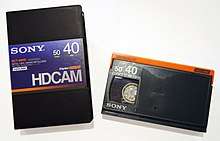HDCAM
HDCAM, introduced in 1997, is a high-definition video digital recording videocassette version of digital Betacam, using an 8-bit discrete cosine transform (DCT) compressed 3:1:1 recording, in 1080i-compatible down-sampled resolution of 1440×1080, and adding 24p and 23.976 progressive segmented frame (PsF) modes to later models. The HDCAM codec uses rectangular pixels and as such the recorded 1440×1080 content is upsampled to 1920×1080 on playback. The recorded video bit rate is 144 Mbit/s. Audio is also similar, with four channels of AES3 20-bit, 48 kHz digital audio.
 HDCAM videotape | |
| Media type | Magnetic tape |
|---|---|
| Usage | Video production |

Like Betacam, HDCAM tapes are produced in small and large cassette sizes; the small cassette uses the same form factor as the original Betamax.
The main competitor to HDCAM is the DVCPRO HD format offered by Panasonic. It uses a similar compression scheme and bit rates ranging from 40 Mbit/s to 100 Mbit/s depending on frame rate.
HDCAM is standardized as SMPTE 367M, also known as SMPTE D-11.
Like all types of videotape, HDCAM is no longer in widespread use, having been superseded by memory cards, disc-based recording formats, and SSDs. Tape-based formats are no longer in widespread use.
SMPTE 367M
SMPTE 367M, also known as SMPTE D-11, is the SMPTE standard for HDCAM. The standard specifies compression of high-definition digital video. D11 source picture rates can be 24, 24/1.001, 25 or 30/1.001 frames per second progressive scan, or 50 or 60/1.001 fields per second interlaced; compression yields output bit rates ranging from 112 to 140 Mbit/s. Each D11 source frame is composed of a luminance channel at 1920 x 1080 pixels and a chrominance channel at 960 x 1080 pixels. During compression, each frame's luminance channel is subsampled at 1440 x 1080, while the chrominance channel is subsampled at 480 x 1080.
HDCAM SR
HDCAM SR was introduced in 2003 and standardised in SMPTE 409M-2005.[1] It uses a higher particle density tape and is capable of recording in 10 bits 4:2:2 or 4:4:4 RGB with a video bit rate of 440 Mbit/s, and a total data rate of approximately 600 Mbit/s.[2] The increased bit rate (over HDCAM) allows HDCAM SR to capture much more of the full bandwidth of the HD-SDI signal (1920×1080). Some HDCAM SR VTRs can also use a 2× mode with an even higher video bit rate of 880 Mbit/s, allowing for a single 4:4:4 stream at a lower compression or two 4:2:2 video streams simultaneously.[2] HDCAM SR uses MPEG-4 Part 2 Simple Studio Profile[1] for compression, and expands the number of audio channels up to 12 at 48 kHz/24-bit.
There are 12 channels of audio recorded uncompressed at 24 bit 48 kHz sampling. Each channel is capable of recording AES3 non-audio data.
HDCAM SR was used commonly for HDTV television production. In the mid-2000s, many prime-time network television shows used HDCAM SR as a master recording medium[3], but it is no longer in widespread use.
Some HDCAM VTRs play back older Betacam variants, for example the Sony SRW-5500 HDCAM SR recorder plays back and records HDCAM and HDCAM SR tapes, and with optional hardware also plays and upconverts Digital Betacam tapes to HD format. Tape lengths are the same as for Digital Betacam, up to 40 minutes for S and 124 minutes for L tapes. In 24p mode the runtime increases to 50 and 155 minutes, respectively.
HDCAM tapes are black with an orange lid, and HDCAM SR tapes black with a cyan lid.
440 Mbit/s mode is known as SQ, and 880 Mbit/s mode is known as HQ.
Sony also announced a higher compression mode called SR Lite.[4][5] As with the 440 and 880 mode, SR Lite utilizes the MPEG-4 Part 2 Simple Studio Profile but decreases the bit rate to 220 Mbit/s for 60i and 183 Mbit/s for 50i. SR Lite is locked at 4:2:2 color sampling but still maintains 10 bit pixel depth. It also allows for 50 and 60p at the cost of a doubled data rate (440 Mbit/s for 60p).
The Sony SRW-5800 HDCAM SR VTR has the ability to record both the left eye and right eye of 3D content to a single tape. It syncs the two eyes together and takes up twice as much space on the tape as a normal recording. Other HDSR decks also support 3D such as the SRW-1 HDCAM SR Portable VTR and the SRW-5500/5000 which can play back either channel A or channel B of the Dual Stream 4:2:2 recording.[6]
References
- "Sony Broadcast & Professional Research Labs:HDCAM-SR".
- Sony HDCAM SR FAQ Archived 2007-12-12 at the Wayback Machine
- "BBC Guidelines to the common technical standards agreed by the BBC, BSkyB, Channel 4, Channel 5, ITV and S4C" (PDF). Mentions HDCAM SR to be the only acceptable delivery format.
- "Sony for Professionals:Open Workflow with MXF and SR Lite".
- HDCAM SR Press Conference "Power Of Images"
- "Broadcast, Professional and Business solutions". www.sony.co.uk.
External links
- Guide To DTV Standards: Video Recording
- Overview of Digital Video Standards -- PowerPoint presentation
